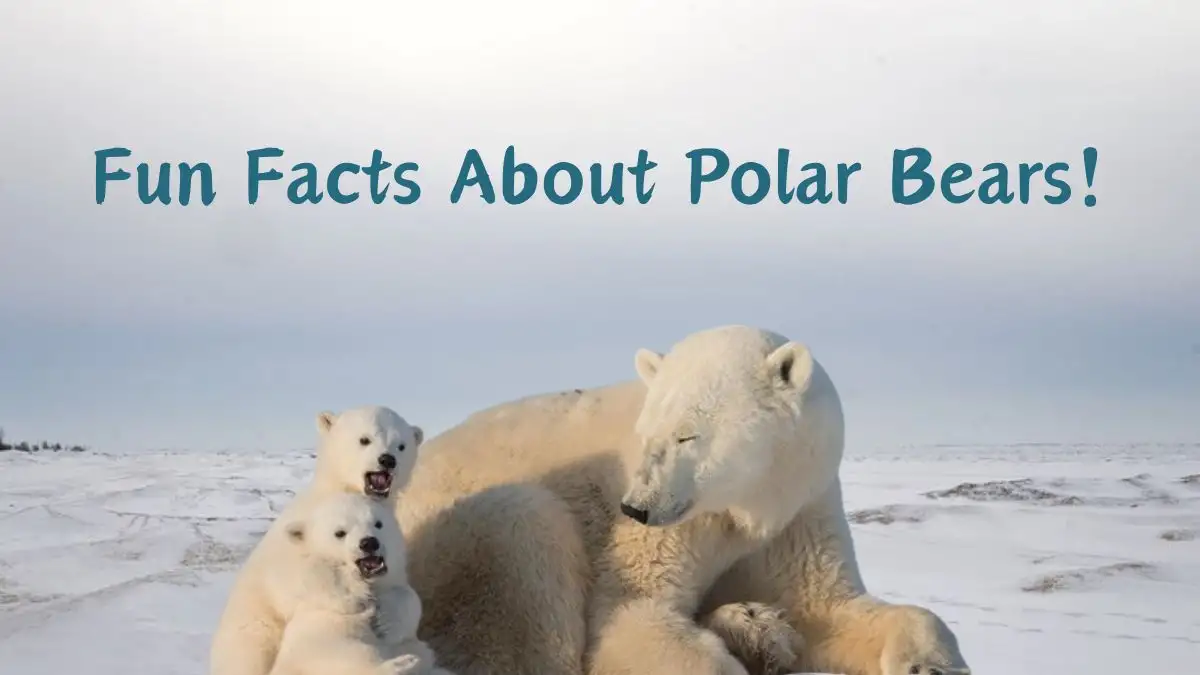Fun Facts About Polar Bears, Things You Might Not Know About Polar Bears
by Deepika V
Updated Mar 26, 2024

Polar Bears
The polar bear is a big bear that lives in the Arctic and nearby places. It's closely related to the brown bear and can mate with it. Polar bears are the largest bears and land carnivores, with adult males weighing between 300 to 800 kilograms.
Females are smaller. They have white or yellowish fur, black skin, and a thick layer of fat. Polar bears are slimmer than brown bears, with a narrower skull, longer neck, and less hump on their shoulders.
Their teeth are sharp for eating meat, and they have big paws that help them walk on ice and swim in water.
Fun Facts About Polar Bears
1. Polar bears live in five countries around the Arctic; Canada, the United States (specifically Alaska), Russia, Greenland, and Norway (specifically Svalbard).
2. They face tough conditions in the Arctic, with winter temperatures ranging from minus 34 degrees Celsius to minus 69 degrees Celsius. The water temperature can get as cold as minus 2 degrees Celsius when seawater freezes.
3. Polar bears have to deal with vast and always-changing sea ice. Because of this, they can have huge areas where they live and move around.
4. When a polar bear is shaved, it reveals black skin underneath its white fur. Polar bears are known for their white fur, but the skin underneath is black. This black skin helps them soak up heat from the sun and stay warm in their icy Arctic habitat.
5. Polar bears don't have white fur like we might think. Their fur is see-through, which means light passes through it. The reason they look white is because their fur reflects light in a way that makes it appear white to us.
6. Polar bears are the biggest bears out of all eight types of bears. They're also the largest carnivores that live on land. The heaviest polar bear ever recorded weighed over 1,000 kilograms.
7. Polar bears have the shortest tail of all bears. A polar bear that's 2.4 to 3 meters long has a tiny tail that's only 7 to 13 centimeters long.
8. Polar bears have an amazing sense of smell. They can smell seals that are almost 1.6 kilometers away and even buried under a meter of snow. Their hearing and ability to see far distances are also really good.
9. They are considered marine mammals because they spend most of their time on ice rather than on land. Polar bears hunt, mate, and live on the ice for many months each year, making them unique among bears.
10. Polar bears mostly eat meat. They hunt animals like the ringed seal and bearded seal, along with other animals like seals. They also eat dead fish, whale carcasses, and sometimes even garbage near places where people live.
11. Many land animals in the Arctic can run faster than polar bears because polar bears can get too hot quickly.
12. In winter, polar bears dig snow pits to stay cozy during bad weather. They rest there until the storm passes.
Things You Might Not Know About Polar Bears
Polar Bears can survive for several days without food
Polar bears can go without eating for several days. When they haven't eaten for about seven to 10 days, their bodies slow down to conserve energy until they can find food again. They mainly eat ringed and bearded seals, relying on their fat reserves for energy. However, climate change is causing food shortages, leading some polar bears to resort to cannibalism.
Polar bears can swim for long time
Polar bears are great swimmers and can swim for a long time. They usually swim at about 6 mph. This skill comes in handy because as the ice melts, they have to swim more. In one study, a tagged female polar bear swam 426 miles in nine days across the Beaufort Sea in Alaska. She lost 22 percent of her body weight during the swim. Another bear in the study swam for 12 days but took breaks along the way.
Polar bears rank higher than us in the food chain
Polar bears are at the top of the food chain, higher than humans. They don't have many predators, and they mainly eat meat, which puts them alongside species like killer whales at the top of the chain. Humans, on the other hand, are more in the middle of the food chain.
Don't worry too much about polar bears attacking humans, though. A study from 2017 found that there have only been 20 fatal polar bear attacks in the past 144 years across countries where polar bears live. However, if food becomes scarce for polar bears, humans living in their territory might face more danger from hungry bears.
Polar Bears fast for a long period
Polar bears spend a lot of time without eating. When they are not hunting seals on the ice, female polar bears fast for a long time. In Canada's Hudson Bay, pregnant polar bears can go without food for up to 240 days, which is almost eight months. With less ice, polar bears have fewer chances to hunt and build up fat stores they need to survive without food. In the past, non-pregnant polar bears fasted for 120 days between hunting seasons.
Scientists can get the DNA of Polar Bear from their footprints
Scientists have found a way to get DNA from polar bears just from their footprints. This helps them learn more about polar bears and how to protect them. They can even figure out what the bears eat by looking at the DNA in their footprints.
Polar bears choose to live alone
After spending four to five months in the den, the polar bear family comes out. The cubs stay with their mother for around two years. During this time, they learn essential skills for surviving in the Arctic.







